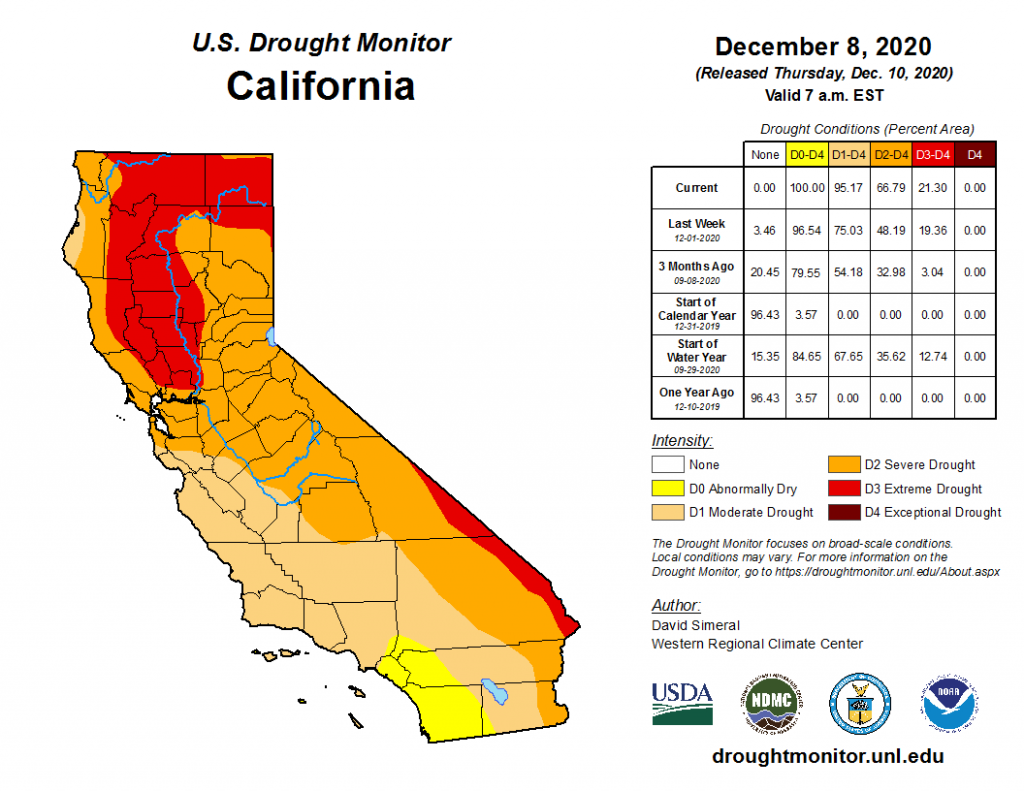Understanding Drought Impacts and Preparing for Changing Conditions
By Michelle Hallack-Alegria, PhD, NV5
Water availability and future water conditions are uncertain, thus planning, preparedness, and designing for sustainable infrastructure to support long-term water resilience in a highly variable climate have become a priority to community leaders. The California Governor’s office released the final 2020 Water Resilience Portfolio on July 28, 2020, including recommended actions for dealing with extreme events, rising temperatures, and aging infrastructure. Recommended actions include maintaining and diversifying water supplies, improving infrastructure to store, move, and share water. This becomes crucial due to recurrent and prolonged drought events. Since 2000, the longest duration of drought in California has lasted 376 weeks (late 2011-early 2019). The most intense period of drought occurred during the summer of 2014 where exceptional drought conditions affected 58.4 percent of California land.
Consequently, a critical challenge for communities is considering and coordinating on multi stressor scenarios in their long-term planning. In addition to population growth, historical hydrological patterns need to be paired with future projections. Planning, decision-making, and resource availability are essential elements to build resilience in a changing environment. Water resources planning (e.g. drought contingency planning) allow water managers to prepare for the effects of extreme events, such as droughts. A portfolio-based approach for achieving a set of resilient water systems becomes an important key in planning. The water resilience portfolio will be unique in each community based on specific available water sources and infrastructure. Our communities face serious water challenges, water conservation is vital, and suitable and safe water supplies are needed to cope with current and future availability scenarios. It is our responsibility to act by protecting water resources for our communities and ecosystems in a cost-effective manner.
In Southern California, extremely dry years are also projected to increase, potentially doubling or more in frequency by the late-21st century. In addition, more frequent fires shorten fire-return intervals which can cause land cover changes such as vegetation type conversion, which is exacerbated by drought conditions. The unusually wet years of 2005, 2011, and 2017 and the droughts of 2001-2004, 2007-2010, and 2012-2015 illustrate the highly variable climate of the region. Southern California has the highest year-to-year variability of any place in the continental U.S. Thus, boosting communities’ capacity for preparation is vital, and depends on planning and improving the resilience of water systems. During the last year, while precipitation returned to the west coast in California and conditions improved, the Southwest continued to show long term impacts. Drought has expanded and worsened in California since the start of the 2020-2021 water year (October 1, 2020 – September 30, 2021) due to below-average precipitation and losses due to evapotranspiration. Drought impacts are growing and preparation for a likely dry year (and second dry year for some areas) is needed as warm and dry conditions favored to continue La Niña conditions expected through Spring. The current seasonal drought outlook for southern California comprising the counties of San Diego, Orange, Los Angeles, and Riverside show a tendency to continue drought development and persistence. Current conditions in California show 95 percent moderate to extreme drought, and abnormally dry conditions meaning dry soils and above normal wildfire potential.
Accordingly, creative and innovative approaches to financing infrastructure and planning projects are essential. State and Federal governments are providing funding alternatives to projects oriented to water resources planning, building resilience, and managing water with a sustainable approach. For instance, the Bureau of Reclamation’s WaterSMART Grant Program supports a proactive approach for states, water districts, Native American Tribes as they plan for and implement actions to build resilience to droughts by increasing water supply alternatives through investments and modernizing existing infrastructure. Example projects can be found in https://www.usbr.gov/drought/applications.html.
For further information on droughts and climate change, please visit:
CNAP California-Nevada Climate Applications Program: https://sioweb.ucsd.edu/programs/cnap
State of California Water Resilience Portfolio Initiative: https://waterresilience.ca.gov/
U.S. Drought Monitor: https://droughtmonitor.unl.edu/
U.S. Bureau of Reclamation Drought Program: https://www.usbr.gov/drought/


